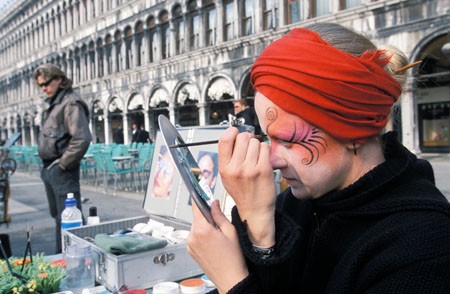Wide-angle lenses, particularly those of focal length 17 - 35mm, are useful when portraying people in the context of their environment. The camera must be close to the subject to give a worthwhile reproduction ratio, and perspective is consequently accentuated. Under these circumstances, perhaps less than a metre from the subject, care must be taken to ensure that facial features do not become grotesque. Depth relationships of different planes in a scene are clearly shown, and relationships between objects appear to change. Also, vertical lines converge if the camera is moved away from the horizontal. What is acceptable is largely a matter of taste.
The broad field of view of a wide-angle lens reveals great swathes of the surroundings, so depth of field, composition and exposure must be carefully considered. When using a 17mm lens focused at one metre and set to an aperture of f/16, depth of field extends from about 50cms to infinity. Background detail is rendered sharp and must be interesting and appropriate if it is to provide context. Off-centre subject placement leaves lots of empty space, so a small or distant secondary subject may be needed to restore visual balance.
 Determining exposure for a wide field of view, where contrast may be extreme, is not completely straightforward. A person's face or body may occupy only a small part of an image. Contrast between the subject and other parts of the image, such as the sky or a dark recess, may well exceed the latitude of a film or sensor. If so, it must be reduced - perhaps by reframing, diffusing the light or using fill. Centre-weighted measurements are obviously a poor compromise where the subject is off-centre. Averaged or multi-segment measurements combined with some fill may prove adequate. Alternatively, take spot measurements from key areas of highlight and shadow, use fill and do some bracketing.
Determining exposure for a wide field of view, where contrast may be extreme, is not completely straightforward. A person's face or body may occupy only a small part of an image. Contrast between the subject and other parts of the image, such as the sky or a dark recess, may well exceed the latitude of a film or sensor. If so, it must be reduced - perhaps by reframing, diffusing the light or using fill. Centre-weighted measurements are obviously a poor compromise where the subject is off-centre. Averaged or multi-segment measurements combined with some fill may prove adequate. Alternatively, take spot measurements from key areas of highlight and shadow, use fill and do some bracketing.
Approaching people closely can be intimidating for both photographer and subject. It is clearly not possible to work at such close range without the subject’s knowledge, so involvement and interpersonal skills are important. At a distance of one metre the photographer is well within the subject’s personal space, and must therefore proceed with particular consideration and sensitivity. Perspective is exaggerated by wide-angle lenses and at close range the effects become obvious. Check that the subject’s features look natural and if a problem is apparent take a step back.
Wide-angle portraiture is more challenging than telephoto work in the sense that the broad environment is more difficult to control than a small area of background. Other people may move around in the background, and contrast may be greater. Fill-in flash can be used to balance the exposure of subject and environment, but particular care is necessary when working at very close range. On-camera flash may need directing downwards towards the subject’s face, and small flash heads typically have a minimum operating distance of about one metre. It can be beneficial to use a diffuser on the flash head, and perhaps also fit a flash warm-up filter to prevent blanching of the subject’s flesh tones.
Try to find environments that tell the viewer something about the subject and their activities. A vegetable market trader might, for instance, be shown close-up with his or her stall and produce in the background. It might also be possible to include other stalls or a smaller secondary subject to balance an asymmetrical composition.






